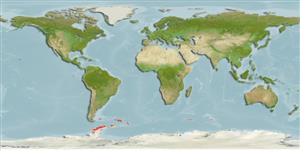>
Perciformes/Notothenioidei (Icefishes) >
Nototheniidae (Cod icefishes) > Nototheniinae
Etymology: Gobionotothen: Latin, gobius = gudgeon + see under Notothenia; gibberifrons: gibberifrons from Latin giber a hump, frons forehead, humped forehead (Ref. 11892).
More on author: Lönnberg.
Environment: milieu / climate zone / depth range / distribution range
ນິເວດວິທະຍາ
ສັດທະເລ ອາໄສຢູ່ໃກ້ໜ້າດິນໃຕ້ພື້ນທ້ອງນ້ຳ; ລະດັບຄວາມເລິກ 6 - 429 m (Ref. 11892). Polar; 53°S - 67°S, 75°W - 75°E
Southern Ocean: Scotia Arc and Heard Island. Also distributed in the South Atlantic, near the southern Shetland, southern Sandwich, southern Orkney Islands, and near South Georgia Island (Ref. 4883).
Length at first maturity / ຂະໜາດ / ນ້ຳໜັກ / Age
Maturity: Lm 37.7 range ? - ? cm
Max length : 55.0 cm TL ຕົວຜູ້/ບໍ່ມີເພດ; (Ref. 5179); common length : 40.0 cm TL ຕົວຜູ້/ບໍ່ມີເພດ; (Ref. 2121)
ຄີ (ໜາມ)ແຂງຢູ່ຫຼັງປາ (ທັງໝົດ): 6 - 8; ຄີຫຼັງຂອງປາ (ຄີອ່ອນ) (ທັງໝົດ): 31-34; ຄີກົ້ນຂອງປາ: 31 - 34. Upper part of head and body irregularly spotted and blotched. Rarely with traces of darker cross-bars, young with irregular cross-bars, broken up into three or four series of alternating spots (Ref. 11892).
Mature females may spawn for the first time from around 6-8 years of age (Ref. 71843).
Dewitt, H.H., P.C. Heemstra and O. Gon, 1990. Nototheniidae. p. 279-331. In O. Gon and P.C. Heemstra (eds.) Fishes of the Southern Ocean. J.L.B. Smith Institute of Ichthyology, Grahamstown, South Africa. (Ref. 5179)
IUCN Red List Status (Ref. 130435)
Threat to humans
Harmless
Human uses
ການປະມົງ: ທີ່ເປັນການຄ້າໜ້ອຍ
ຂໍ້ມູນຕື່ມອີກ
ຜູ້ຮ່ວມມືຮູບStamps, Coins Misc.ສຽງຫອຍມີພິດຊະນິດນຶ່ງທີ່ອາໄສໃນທະເລຄວາມໄວປະເພດການລອຍເນື້ອທີ່ເຫືອກOtolithsສະໝອງວິໄສທັດ
ເຄື່ອງມື
Special reports
Download XML
ແຫຼ່ງອີນເຕີເນັດ
Estimates based on models
Preferred temperature (Ref.
123201): -1.3 - 0.7, mean -0.6 °C (based on 36 cells).
Phylogenetic diversity index (Ref.
82804): PD
50 = 0.5312 [Uniqueness, from 0.5 = low to 2.0 = high].
Bayesian length-weight: a=0.00407 (0.00344 - 0.00483), b=3.24 (3.19 - 3.29), in cm total length, based on LWR estimates for this species (Ref.
93245).
ຊັ້ນເຂດຮ້ອນ (Ref.
69278): 3.3 ±0.2 se; based on diet studies.
ຄວາມຢືດຢຸ່ນ (Ref.
120179): ຕຳ່, ປະຊາກອນຕຳ່ສຸດທີ່ໃຊ້ເວລາສອງເທົ່າ 4.5 - 14 ປີ (Fec=21,699; tm=10).
Fishing Vulnerability (Ref.
59153): Moderate vulnerability (42 of 100).
Climate Vulnerability (Ref.
125649): Moderate to high vulnerability (46 of 100).
Nutrients (Ref.
124155): Calcium = 19.7 [11.5, 46.6] mg/100g; Iron = 0.384 [0.181, 0.754] mg/100g; Protein = 17.7 [15.5, 19.6] %; Omega3 = 0.329 [0.180, 0.572] g/100g; Selenium = 16.6 [7.0, 41.1] μg/100g; VitaminA = 12.4 [2.7, 59.6] μg/100g; Zinc = 0.497 [0.332, 0.747] mg/100g (wet weight); based on
nutrient studies.
